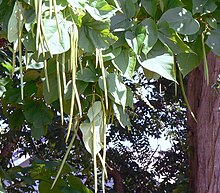Catalpa(/kə-ˈtæl-pə/,/kə-ˈtɑːl-pə/[1]), commonly also calledcatawba,is agenusofflowering plantsin thefamilyBignoniaceae,nativeto warmtemperateandsubtropicalregions of North America, the Caribbean, and East Asia.
| Catalpa Temporal range:
| |
|---|---|

| |
| Catalpa speciosaflowers, leaf and bark | |
| Scientific classification | |
| Kingdom: | Plantae |
| Clade: | Tracheophytes |
| Clade: | Angiosperms |
| Clade: | Eudicots |
| Clade: | Asterids |
| Order: | Lamiales |
| Family: | Bignoniaceae |
| Tribe: | Catalpeae |
| Genus: | Catalpa Scopoli |
| Species | |

Description
editMostCatalpaaredeciduoustrees; they typically grow to 12–18 metres (40–60 ft) tall, with branches spreading to a diameter of about 6–12 metres (20–40 ft). They are fast growers and a 10-year-old sapling may stand about 6 metres (20 ft) tall. They have characteristic large, heart-shaped leaves, which in some species are three-lobed. The appearance of the leaves sometimes causes confusion with species such as the unrelated tung tree (Vernicia fordii) andPaulownia tomentosa.Catalpaspecies bear broadpaniclesof showy flowers, generally in summer. The flower colour generally is white to yellow. In late summer or autumn the fruit appear; they aresiliquesabout 20–50 centimetres (8–20 in) long, full of small flat seeds, each with two thin wings to aid in wind dispersal.
The large leaves and dense foliage ofCatalpaspecies provide good shelter from rain and wind, making the trees an attractive habitat for many species of birds. They do not present many threats of falling limbs, but the dark-brown fruit husks that they drop in late summer may be a nuisance.
ThoughCatalpawood is quite soft, it is popular for turning and for furniture when well seasoned, being attractive, stable and easy to work.[2]
Most catalpas begin flowering after roughly three years, and produce fruit after about five years.[citation needed]
Species
editThe two North American species,Catalpa bignonioides(southern catalpa) andCatalpa speciosa(northern catalpa), have been widely planted outside their natural ranges asornamental treesfor their showy flowers and attractive shape. Northern and southern catalpas are very similar in appearance, but the northern species has slightly larger leaves, flowers, and bean pods. Flowering starts after 275growing degree days.Catalpa ovatafrom China, with pale yellow flowers, is also planted outside its natural range for ornamental purposes. This allowedC. bignonioidesandC. ovatato hybridize, with the resultantCatalpa × erubescensalso becoming a cultivated ornamental.
List of species
editSources:(GRIN accepts 8 species)[3](KEW accepts 8 species)[4]
- SectionCatalpa(North America and East Asia):
- Catalpa bignonioidesWalter– southern catalpa
- Catalpa bungeiC.A.Mey.– Manchurian catalpa
- Catalpa fargesiiBureau(sometimes treated as a synonym ofC. bungei)
- Catalpa ovataG.Don– Chinese catalpa, yellow catalpa
- Catalpa speciosaWarder ex Engelm.– northern catalpa
- SectionMacrocatalpa(Caribbean):
- Catalpa brevipesUrb.
- Catalpa purpureaGriseb
- Catalpa macrocarpaEkman
- Catalpa longissima(Jacq.) Dum.Cours
Evolution
editThe genus likely originated in North America, with the oldest fossils of the genus being seeds from the EarlyOligocene(Rupelian) ofOregon,USA. Fossil species are also known from the Late Oligocene (Chattian) of Europe, but they appear to have become extinct in the region by theMioceneepoch. The fossil speciesCatalpa hispaniolaeknown fromDominican amberindicates the presence of the genus in the Caribbean by the Miocene. Fossil leaves from China indicate their presence in East Asia by the mid Miocene. The living North American speciesC. bignonioidesandC. speciosaseem to have originated from a back-migration to North America from East Asia, probably during the late Miocene.[5]
Etymology
editThe name derives from theMuscogeename for the tree, "kutuhlpa" meaning "winged head" and is unrelated to the name of theCatawba people.[6][7]The spellings "Catalpa" and "Catalpah" were used byMark Catesbybetween 1729 and 1732, andCarl Linnaeuspublished the tree's name asBignonia catalpain 1753.[8][9]Giovanni Antonio Scopoliestablished the genusCatalpain 1777.
The bean-like seed pod is the origin of the alternative vernacular namesIndian bean treeandcigar treeforCatalpa bignonioidesandCatalpa speciosa,respectively.
Food source
editThe tree is the sole source of food for the catalpa sphinx moth (Ceratomia catalpae), the leaves being eaten by thecaterpillars.When caterpillars are numerous, infested trees may be completely defoliated. Defoliated catalpas produce new leaves readily, but with multiple generations occurring, new foliage may be consumed by subsequent broods. Severe defoliation over several consecutive years can cause death of trees. Because the caterpillars are an excellent live bait for fishing, some dedicated anglers plant catalpa mini-orchards for their own private source of "catawba-worms",particularly in thesouthern states.[10]
Other uses
editCatalpa is also occasionally used as atonewoodin guitars.
References
edit- ^"Definition of CATALPA".merriam-webster.Retrieved2024-08-15.
- ^Maroni, Kristi; Sarah Domville (2003-12-04)."Catalpa Tree".Tree Walk.Nazareth College of Rochester.Archived fromthe originalon 2008-12-10.Retrieved2009-04-30.
- ^"Species Records ofCatalpa".Agricultural Research Service(ARS),National Genetic Resources Program,Germplasm Resources Information Network(GRIN).USDA.Retrieved12 April2021.
- ^"Catalpa Scop. | Plants of the World Online | Kew Science".Plants of the World Online.Retrieved12 April2021.
- ^Dong, Wenpan; Liu, Yanlei; Li, Enze; Xu, Chao; Sun, Jiahui; Li, Wenying; Zhou, Shiliang; Zhang, Zhixiang; Suo, Zhili (January 2022)."Phylogenomics and biogeography of Catalpa (Bignoniaceae) reveal incomplete lineage sorting and three dispersal events".Molecular Phylogenetics and Evolution.166:107330.Bibcode:2022MolPE.16607330D.doi:10.1016/j.ympev.2021.107330.PMID34687844.
- ^Gerard, William R. Plant names of Indian origin_II. Garden and Forest. volume 9, no. 436. page 262. (1896).
- ^Cassidy, Fred. Lemmatization—The case of "Catalpa". in McIntosh, Language Form and Linguistic Variation: Papers Dedicated to Angus McIntosh. Amsterdam: Benjamins, 1982. Current issues in linguistic theory, 15.
- ^Catesby, Mark.The natural history of Carolina, Florida and the Bahama Islands. volume 1. page and plate 49.
- ^Linne, Carolus von Linne. Species Plantarum. 1st edition. 1753. volume 2. page 622
- ^Hyche, L. L., "The Catalpa Sphinx" Department of Entomology Auburn University, Retrieved on 2009, 05-16.